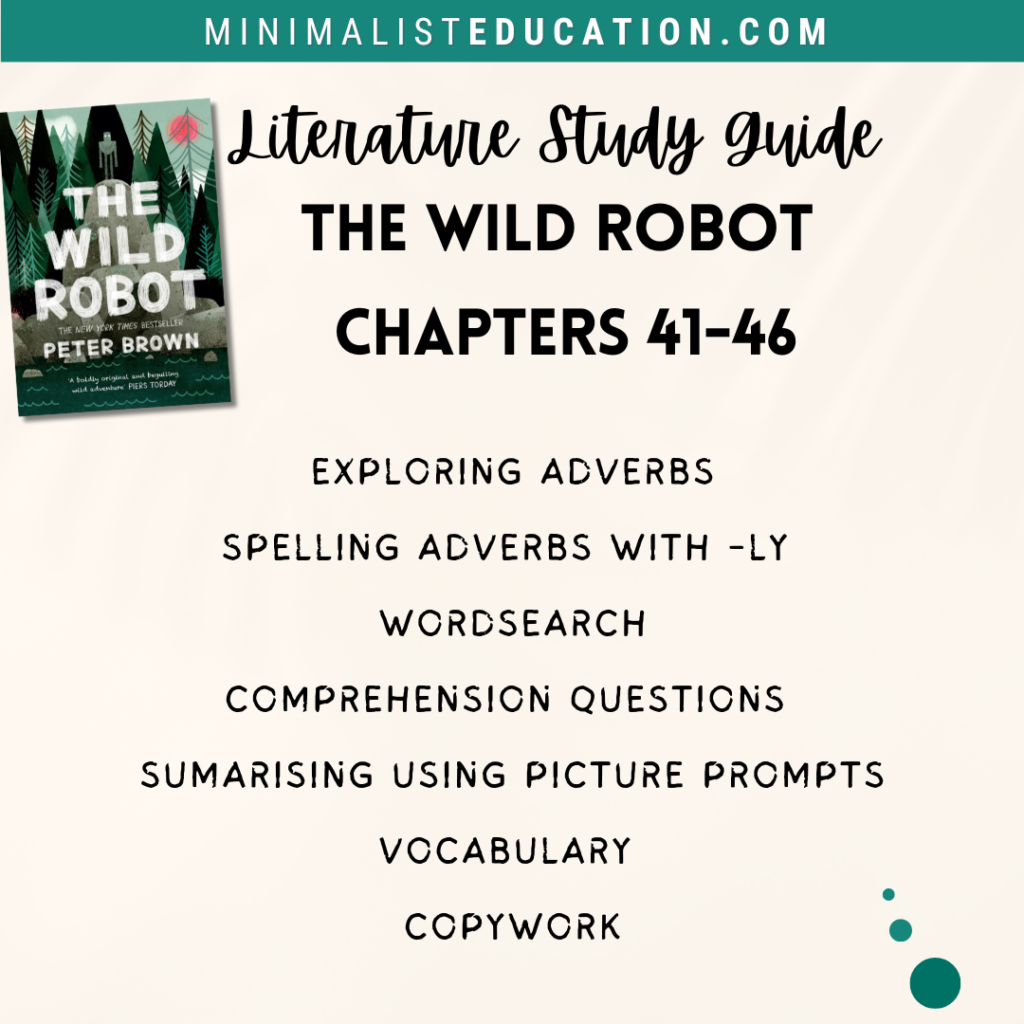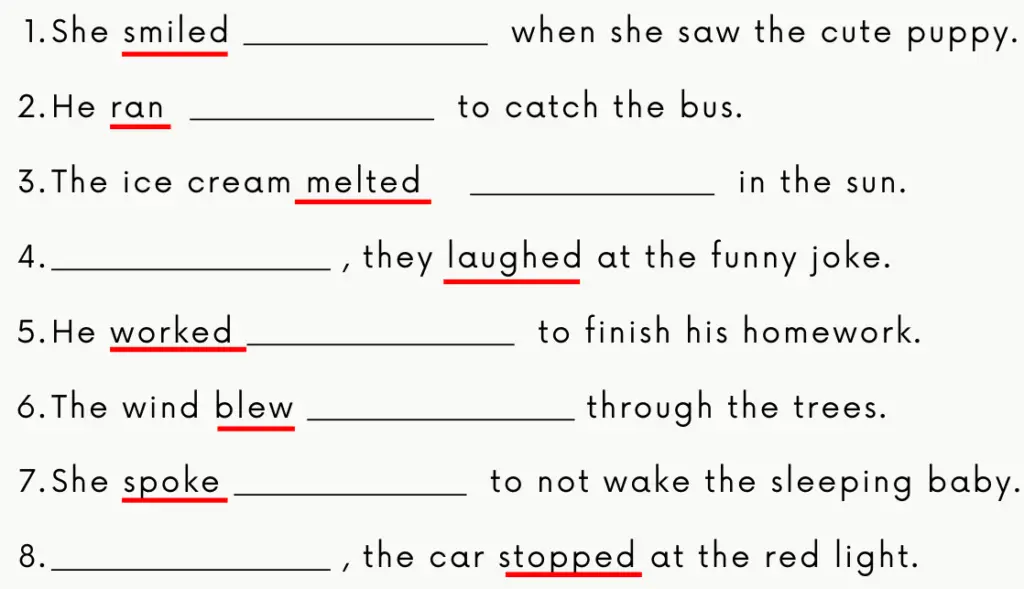Exploring Adverbs: The Wild Robot Chapters 41-46 Study Guide

This weeks study guide of The Wild Robot focuses on adverbs. Adverbs are significant in helping us as readers understand the context of when, where, how, how often, to what extent the actions we read about take place. In our writing, a well-placed adverb or adverbial phrase will help keep our writing concise, whilst giving the readers help towards imagining the action, the mood of the characters and what their intentions are.
Also in this week’s Study Guide: comprehension questions, spelling adverbs by adding the suffix -ly, copywork, summarising and practising new vocabulary.
Welcome to Week 8 of The Wild Robot Study Guide, Chapters 41 – 46. Let’s begin!
Access the rest of this study guide here.
In this post:
- The Wild Robot teaching notes and answers for Week 8 Chapters 41-46.
- Download The Wild Robot Study Guide for Week 8 Chapters 41-46.
The Wild Robot Chapters 41-46 Study Guide Teaching Notes And Answers
Read Chapters 41-44:
- Ex. 1 Answer the comprehension questions based on chapters 41-44. These can be discussed first before writing.
This week begins with comprehension questions for chapters 41-44. Read these chapters with your child and then discuss the answers together before your child attempts to answer the questions. Text-based comprehension questions enhances children’s ability to analyse and interpret the text, promoting critical thinking skills. Read more about strategies to implement comprehension in your homeschool here.

Teaching Note: Adverbs
Adverbs play a crucial role in enhancing the richness of a sentence. While too may adverbs dilute the effectiveness of a piece of writing, it is important to understand what they are, so children can use them to increase their own understanding of a text and also use them in their own writing.
Children are introduced to adverbs using an extract from The Wild Robot:
“The other goslings were teasing him about something when they suddenly burst into laughter.” Chapter 42 page 123
- Ex. 2 Copy this passage in your best handwriting. Make sure it is spelt and punctuated correctly.
- Read the teaching notes on adverbs.
In short, adverbs are words that describe how, when, where and why a verb happens. Adverbs are a way to provide additional information about verbs.
This would be an excellent point to review adjectives: words that describe nouns. If you need to at this point, go over the definitions of nouns, verbs, and adjectives, do that and leave teaching of adverbs for another day.
In the extract given, the word “suddenly” is an adverb which describes how the other goslings burst into laughter.
Adverbs are important in sentences as they add extra information about how, when, where, or why something happens.
How: Adverbs tell us more about how a verb occurs. For example, if you say, “She ran,” it tells us what she did.
But if you say, “She ran quickly,” the word “quickly” is an adverb, and it tells us how she ran – very fast!
When and Where: Adverbs can also tell us when or where something happened. For instance, if you say, “We went to the park yesterday,” “yesterday” is an adverb that tells us when you went.
And if you say, “She put the book here,” “here” is an adverb telling us where she put the book.
Why and How Much: Adverbs can also give us information about why or to what extent something happened. For instance, if you say, “He jumped very high,” “very” is the adverb, and it tells us how high he jumped – he jumped really, really high!
Exercises to Practice Adverbs
- Ex. 3 Sort the adverbs, keeping in mind that an adverb is something that tells you where, when or how something is done.

This exercise requires children to sort out words based on whether they are adverbs or not.
Get kids to put each word in a simple sentence to see if it is modifying the verb. This activity should increase their understanding of how adverbs function in sentences.
- Ex. 4 First, underline the verb in the given sentence, then add an adverb which describes how, when, where or why the verb happens.

By prompting kids to underline the verb in a sentence, they are encouraged to identify the action or state of being in a sentence. Understanding what the verb is in a sentence is crucial for understanding and identifying adverbs because adverbs primarily (though not exclusively) modify or provide additional information about verbs.
Once the verb is identified, kids need to add an adverb that enhances or modifies the verb by providing information about how, when, where, or why the action occurs. This step requires them to think critically about the context and the kind of information an adverb can add to the sentence.
This helps them in understanding adverbial functions; by associating adverbs with specific details related to the verb (how, when, where, or why), children start to grasp the different functions adverbs serve within sentences.
Read Chapters 45–46:
- Ex 1 Practice spelling these -ly adverb words where the adjective root word doesn’t change when the suffix -ly is added. See if all of them can be found in the wordsearch.

Adverbs are often formed when the suffix -ly is added to an adjective root word. Sometimes, the root word spelling doesn’t change when the suffix -ly is added.
Off course there are many instances where the spelling of the root word does change when changing an adjective to an adverb. If you want to at this stage you can also cover these rules.
- Ex. 2 Using the pictures provided, write a summary to explain what happened at these parts of the story.
The activity involving summarising events from from Chapter 45 and 46 has the benefit of practising recalling the storyline from those chapters. It encourages kids to recall key events, characters, and settings, thereby enhancing their ability to retain information from the text. By using the visual prompts, it encourages them to be really succinct and precise.
- Ex. 3 Use a dictionary to write the definition of each word vocabulary word taken from Chapters 45 and 46 of The Wild Robot, and then put it in your own sentence.
This book, The Wild Robot, exposes kids to so much rich vocabulary that if would take forever to stop and learn and use each one. Reading and being exposed to new words presented within a specific context will help our kids to infer the meaning of unfamiliar words based on how they’re used in sentences or paragraphs.
Every so often though, I do think we need to be more intentional about vocabulary learning and not leave it to chance. This exercise requires kids to look up and write definitions of some of the new words. I freely admit this is a horrible task, but necessary to really understand the meanings of unfamiliar terms.
By getting kids to form sentences with the newly learned words promotes language application skills. It encourages children to use these words in their own context, strengthening their ability to incorporate new vocabulary into their speaking and writing. It allows them to own the words.
Download Your Copy of The Wild Robot Study Guide for Chapters 41-46:
Get your copy of The Wild Robot
If you are using this study guide, please consider making any purchase from Amazon using the link:
I may get a commission if you decide to make any purchases through my links, at no extra cost to you. This helps towards the cost of hosting this website. Thank you.
I hope you and your children enjoyed this week’s reading and activities. You will find that paying attention to adverbs when writing aids in developing children’s ability to construct more descriptive and detailed sentences. It also helps us to understand the text better and make more accurate inferences about the situation and characters when we read.
I would love to hear about you liked and didn’t like about this weeks activities. Comment below!
Leave a Reply